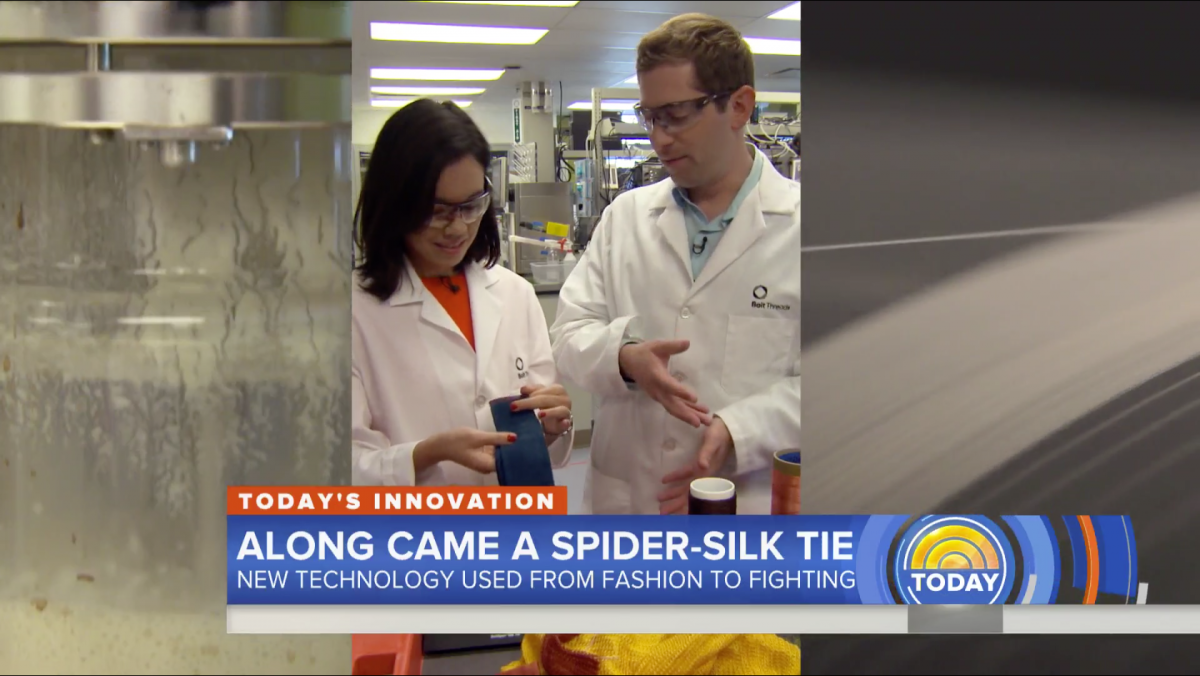Brad DeLong, the chief economist of the Blum Center, has spent the past four decades researching, writing about, and influencing public policy in the areas of business cycle dynamics, economic growth, behavioral finance, political economy, economic history, international finance, and the history of economic thought. He graduated summa cum laude from Harvard in 1982, and earned a PhD in economics, also from Harvard. Thereafter, he taught economics at MIT, Boston University, and Harvard, becoming in 1991 a John M. Olin Fellow at the National Bureau of Economic Research.
DeLong joined the UC Berkeley faculty as an associate professor in 1993; however, from 1993 to 1995, he served as Deputy Assistant Secretary for Economic Policy at the U.S. Department of the Treasury under the Clinton Administration. There, he worked on the 1993 federal budget, the health reform effort, and the Uruguay Round of the General Agreement on Tariffs and Trade and the North American Free Trade Agreement. He became a full professor at Berkeley in 1997, and has since also served as co-editor of the Journal of Economic Perspectives, research associate of the National Bureau of Economic Research, and a fellow of the Institute for New Economic Thinking.
Delong is a prolific contributor to both academic thought and the popular press. Among his scholarly works are: Macroeconomics (a textbook continuously in print since 2002), The End of Influence: What Happens When Other Countries Have the Money (with Stephen Cohen), and Concrete Economics: The Hamilton Approach to Economic Growth and Policy (with Stephen Cohen). He is currently at work on The Economic History of the Twentieth Century: Slouching Towards Utopia? DeLong blogs at “Grasping Reality with Both Hands” and writes a monthly column for Project Syndicate.
The Blum Center sat down with Professor DeLong to gauge his views of the future of development.
Why did you decide to become an economist?
I would say that it was a long, slow process. As I look back, some milestonesstand out. Back when I was a child, the father of my best friend, Michael Froomkin, was an economist— Joseph Froomkin always seemed to have very interesting and smart things to say that came at the world from a different and very insightful perspective than others. When I was 12, I think, at the American Academy of Arts and Sciences meeting I got to spend a day playing with the “World Dynamics” global economic-ecological model. The model, I now realize, was very wrong—we are certainly not on any of the trajectories it forecast. But the idea that you could do such a thing was very interesting. When 1982 came around and I graduated from college, the unemployment rate was heading for 11 percent: my classmates weren’t having as easy a time getting jobs, and so staying in school seemed attractive. Becoming a lawyer seemed to involve too much proofreading of documents; becoming a lab scientist seemed to involve too much moving of small volumes of liquid from one test tube to another.
How have your views on economic policy and economic history developed over the course of your career?
I do not think that they have changed that much. If they have changed, it is in the direction of having less trust in economic theory as anything other than a shorthand way of crystallizing the lessons from history. I no longer think theory generates insights. I think theory provides a filing system for insights derived from history and practice.
What did you learn during your tenure as Deputy Assistant Secretary for Economic Policy at the U.S Department of Treasury?
Newt Gingrich was a real shock—that there actually was such a self-centered politician, for whom facts on the ground and what the consequences of policies would be for real people, was a shock. His electoral success did very bad things to the Republican Party. But outside of Gingrich and his zone of influence, I was impressed and gratified by how much everyone else in Washington, D.C. cared—about getting the facts right, about getting the policies right, about being good stewards for the country and the world, about trying to figure out how to bring us all closer to utopia.
What interests you most in the field of economic development today?
I am not sure if “interests” is the right word—perhaps “worries” is. There is the big question of the future economic role of “skilled” and “semi-skilled” workers. For the past 200 years, the royal road for a country or a sector to achieve successful economic development has been to use its low wage level to develop a comparative advantage and export industry in labor-intensive manufacturing. You thus borrow the middle-class of the global economic core to provide demand for the goods you manufacture and place them in global value chains. And so you can build up a community of engineering practice around which other processes of technology transfer can develop. By doing this, developing economy after developing economy—starting with the United States and continuing to Germany and most recently in China and Vietnam—have proved capable of importing necessary technologies and then nurturing the communities of engineering practice needed to raise productivity further, catching up at least partway to the global economic core.
But as Harvard’s Michael Kremer taught me fifteen years ago, it doesn’t look like there are going to be an awful lot of relatively low-wage, relatively low-skilled manufacturing jobs out there over the next 30 years. Will China and maybe Vietnam be the last countries for this kind of development? And if so, what alternatives do the structural changes driven by advancing technology open up, if any?
Other scholars to consider in thinking about this issue are: W. Arthur Lewis, the only Nobel Prize winner in economics from the island of St. Lucia. He wrote a book called The Evolution of the International Economic Order, laying out how this has worked. And Robert C. Allen wrote a book for Oxford University Press called Global Economic History: A Very Short Introduction. Most recently, Richard Baldwin has written a book called The Great Convergence: Information Technology and the New Globalization about the coming of the value chain world and its implications for global economic structure.
But even these three books don’t have a great deal to bear on the peculiar problems this provides for developing economies. I am planning a conference this fall at the Blum Center to get people together to talk about this question of the future of economic development.
Amartya Sen in Development as Freedom wrote: “Development consists of the removal of various types of unfreedoms that leave people with little choice and little opportunity of exercising their reasoned agency. The removal of substantial unfreedoms, it is argued here, is constitutive of development.” How would you define the unfreedoms that people in low-income regions and countries might experience in the coming decades due to advances in AI, automation, etc.?
The first unfreedom is obviously and simply: poverty.
I was reading 19th-century economist John Stuart Mill before I came here. Writing in 1871, Mills said: “It is questionable if all the mechanical inventions yet made have lightened the day’s toil of any human being.” In his day, he wrote, there was indeed higher productivity and there were a lot more machines. Together they had enabled a greater population to live the same life of drudgery and imprisonment; an increased number to make fortunes; and an increased number to achieve the comforts of the middle class. But they had not had any positive effects on working class standards of living. And in his description of working-class life, Mill used the word “imprisonment”.
Pause there. John Stuart Mill, founding utilitarian, founding libertarian, one of the people most focused on “freedom” as the primary value, thought back in 1870 that the Industrial Revolution had failed. It has left the working class “imprisoned” because it had left them in poverty. “Imprisonment” is a very strong form of unfreedom: you are locked in a cage. Yet the working class John Stuart Mill saw around them had all the “negative freedom” that Sir Isaiah Berlin could have wanted.
But if John Stuart Mill sees freedom not as merely the absence of legal constraint or personal domination but as requiring enough wealth and social power to, as Sen puts it, “exercise reasoned agency,” who are we to disagree?
Lots of unfreedom could go away if only we could rearrange the process of economic development, so that the fruits of increased productivity would flow to the relatively poor in the form of income. Give people things to do that the outside world regards as valuable. But this also requires that you have to protect the property rights that the working classes have—or else rich and powerful people in your neighborhood will steal your things from you, and it does not matter much if they steal them “legally.”
Do you believe a Universal Basic Income is a feasible public policy to address growing inequality?
Milton Freedman, one of the founders of the Chicago School, was a strong believer in UBI, so it’s definitely out there. There are all kinds of worries about whether it is sociologically and politically unsupportable. There is a strong idea that people simply should never “get something for nothing.” I have never really understood this. We all get a good deal of something for nothing.
If you removed the society around me and all the gifts it has given to me—if you simply put me out in the Sierra foothills, naked, with my abilities to make tools with my own hands, I would starve to death in a month. We are able to be overwhelmingly productive today. But we are so only where we stand on the shoulders of giants, and use a great deal of stuff that has been given to us for free by those who came before us. To ignore this—it is to be born on third base and imagine that you hit a triple.
What about UBI within the foreign aid context, for example, the experiments with cash transfers?
The argument for cash transfers is that you want the people who have a strong sense of how they need resources to be able to spend their own money. The argument against cash transfers is that it’s relatively easy for local power brokers to take the cash away.
I believe delivering direct services, because you have economies of scale, has a great deal to be said for it. I have never understood the argument that service delivery or cash transfers harms people’s work ethic. People really do want to do useful and productive things with their lives overwhelmingly. Look, I had a rich grandfather. His wealth has been flowing to me to the tune of $20,000 per year since I was born until I turned 50. That’s a $20,000 UBI for me. Yet I do not see anyone wandering around saying this was a positively bad thing for me.
Do you use the term the “Fourth Industrial Revolution” to talk about the economic effects of AI, blockchain, nanotechnology, quantum computing, and biotechnology?
Well, it’s not “industrial.” There were two industrial revolutions. Coal and steam and cotton textiles comprised the first one. Then there were the new technologies of the 1880s and 1890s: internal combustion engines, oil, electricity, organic chemicals—that was the second. And I have never understood what the third was supposed to be.
ICT [information communication technology] is a post-industrial revolution. I just call it the ICT revolution, because as Alan Greenspan began saying in the 1990s, the most interesting thing is that the weight of what we are producing is folly. From 1700 to 1990, every year we made more and more stuff in terms of what is masses. And then in 1990, we began making stuff that has had less physical mass.
What does the discipline of economics bring to students taking Blum Center courses on poverty interventions?
Economics is good at getting the second and third order effects rights. For example, when something changes, people will start acting differently as their opportunities change—as the prices, both formal prices and informal prices, are transformed. But as they change what they do, that will affect the environment in which others can act, and what there opportunities are. Economics is very good at tracing those consequences through. And it does so in a way that gets you to not just qualitative but quantitative answers. That is a key analytic perspective—not the only valid one, but a key one.
What is your favorite period in economic history, given your interest in development issues?
I would say from 1870 to 1900, with the advent of: 1) the submarine telegraph cable; 2) the iron-hold, screw-propelled, ocean-going steamship; and 3) the industrial research lab and the arrival of machinery that could be deployed pretty much anywhere in the world.
These three changes made globalization and development on a large-scale possible. Before 1870, the most productive machines by and large did not work outside of England and New England in a way that would make them profitable to use. Before 1870, global communications were far from instantaneous. And before 1870, transportation costs were still relatively expensive enough to keep much of what was made in the periphery from being potentially valuable to the world’s industrial core. After 1870, none of these were true.
The world, however, greatly fumbled the opportunity. Since 1870, our failures of development have arisen from things we have done to ourselves. They have not been because of the absence of usable technologies, blockages to communication, or the tyranny of distance.
What is missing in the conversations today about international development—from economists, technologists, public health specialists?
It is the blind philosophers and the elephant problem. Economists miss the sociology. Sociology miss the economics and also the politics. Engineers miss the fact that the societal systems have to have the incentives for this stuff to actually be used in a way that’s worthwhile.
There are all kinds of ways in which things have gone horribly wrong. For example, think of 1650 in Poland, along the Vistula River. Holland was undergoing an economic boom. And so it was turning its grain fields from places where grain was grown to places where flowers were grown and where cows ate grass to produce milk to be turned into cheese. Suddenly, Holland needed a lot more wheat, which was easy to grow in Poland and, with better maritime technology, cheaply shipped to Amsterdam.
Was this a bonanza for the people of Poland? No. There work became more valuable, but they did not become higher paid. The nobles of Poland took the people and turned them into serfs. It was not a good time for Poland, even if it was a good time for “globalization,” in the sense of the rapid development of ways to grow more wheat faster in smaller spaces and then ship the wheat to places where it was very valuable.
Those are the kinds of things to look out for. Those are the kinds of things to fear.
What’s worked to take people out of poverty?
Land reform, nitrogen, and access to some place where you can sell your skills. What hasn’t taken people out of poverty is this kind of scenario: When the government of Mozambique prohibits the export of cashews to India, because it wants the products of the cashew trees of Mozambique funneled through four sets of South African entrepreneurs, each of whom runs one of the four cashew processing plants in Maputo and have a cartel agreement with respect to the price they will pay to cashew farmers.
What is the role of the university in all these complexities about economic development, whether locally or internationally?
To bring people up to speed on what the issues, opportunities, problems, and dilemmas are. To keep the conversation honest. To have a place where people can think and speak, without having to please powerful people by saying what they want to hear right now.

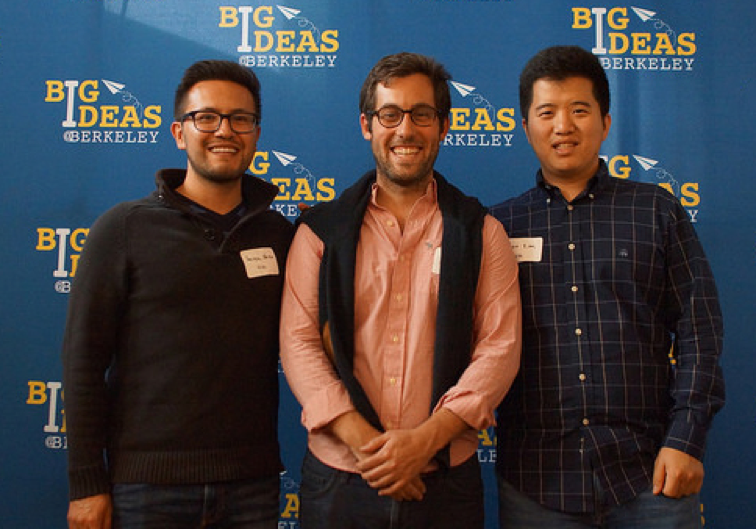
 Basic surgeries are far from basic. They require approximately 50 tools, which take about 2 minutes each for an experienced technician to clean. Operations in a trauma unit require as many as 400 tools. And in both environments, surgical tools can be easily misplaced, thrown away, or misassembled. In fact in the U.S. alone, busy surgical teams inadvertently leave an instrument
Basic surgeries are far from basic. They require approximately 50 tools, which take about 2 minutes each for an experienced technician to clean. Operations in a trauma unit require as many as 400 tools. And in both environments, surgical tools can be easily misplaced, thrown away, or misassembled. In fact in the U.S. alone, busy surgical teams inadvertently leave an instrument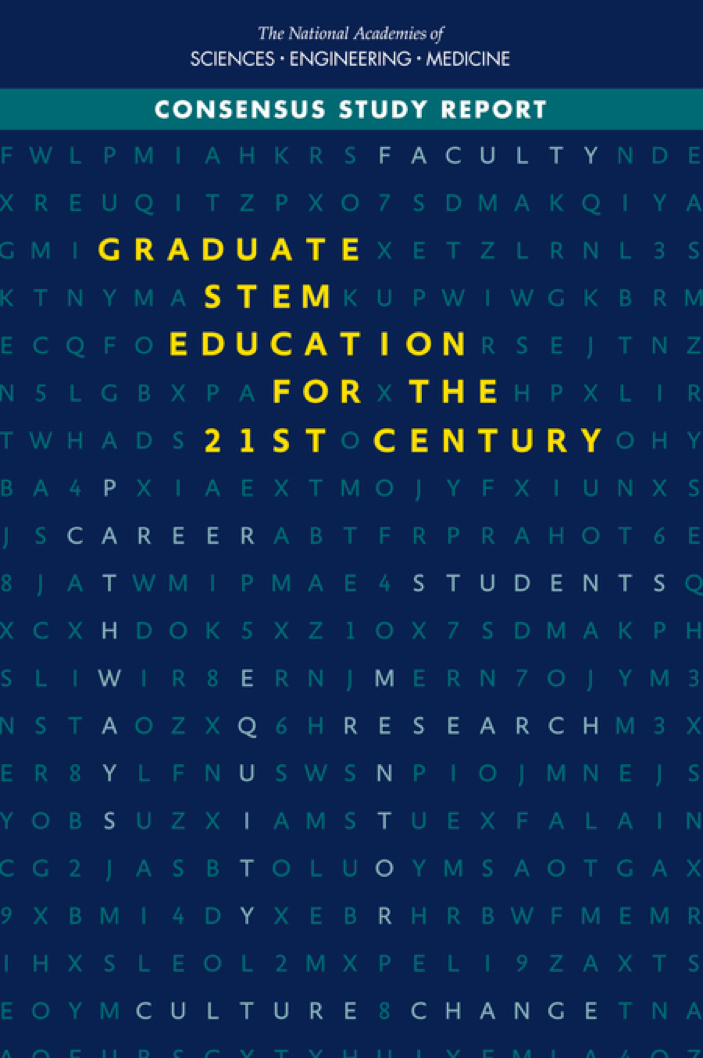

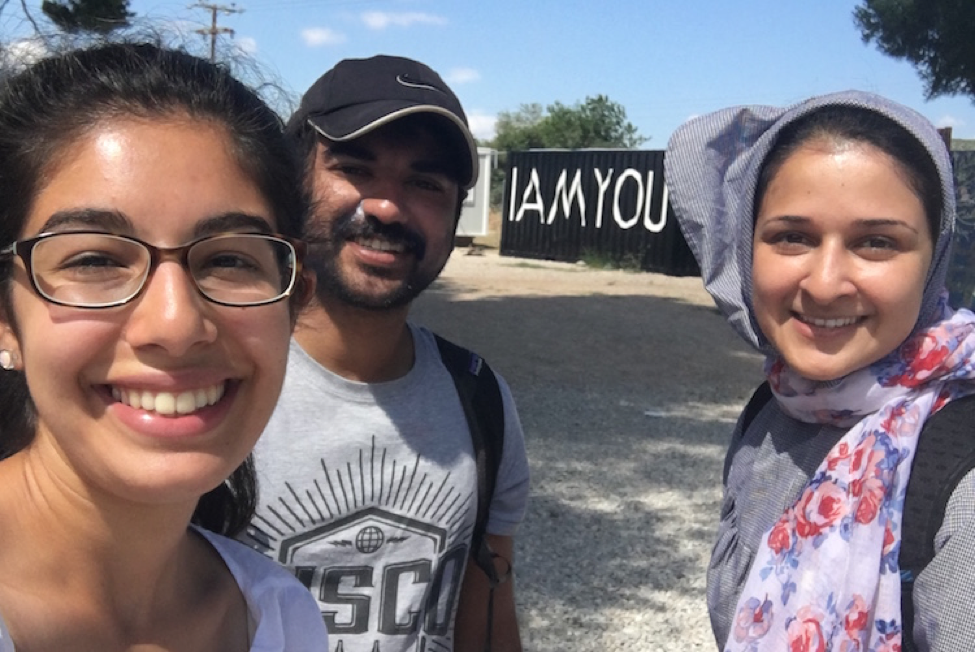
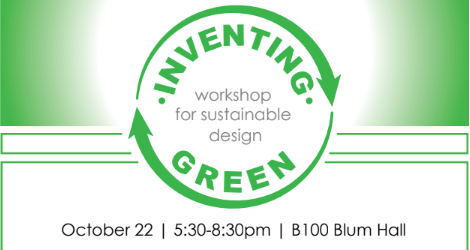
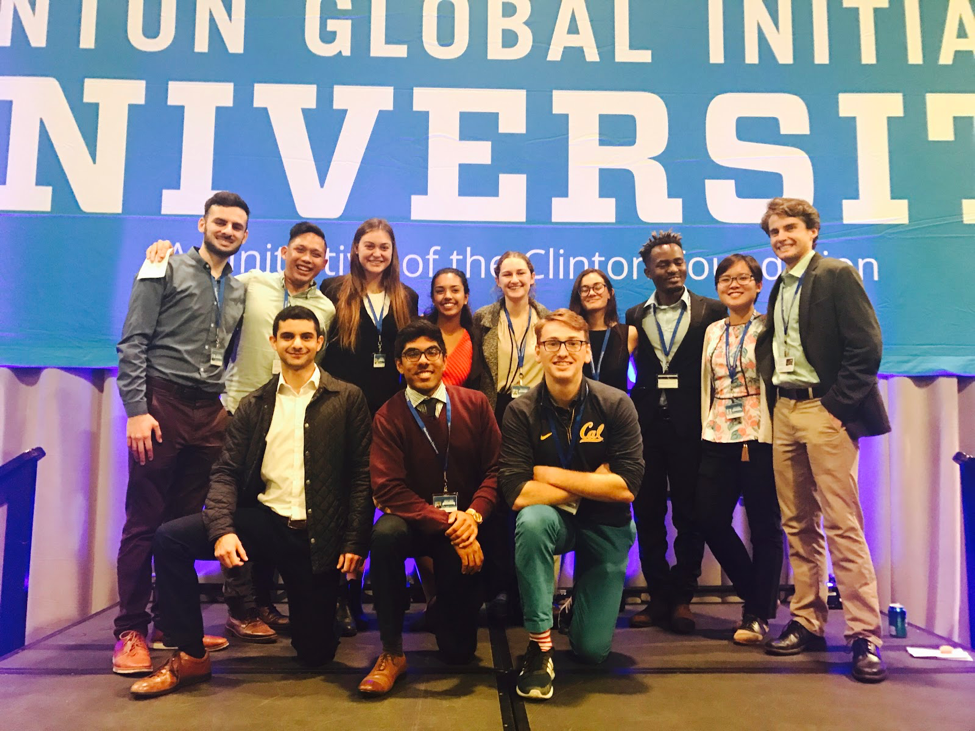





 The Blum Center is home to
The Blum Center is home to 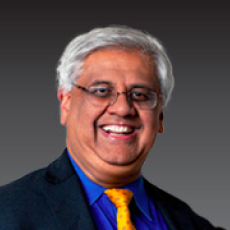
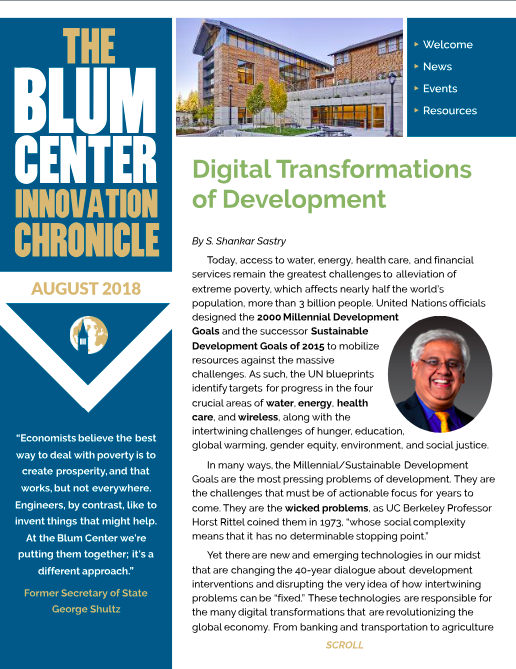
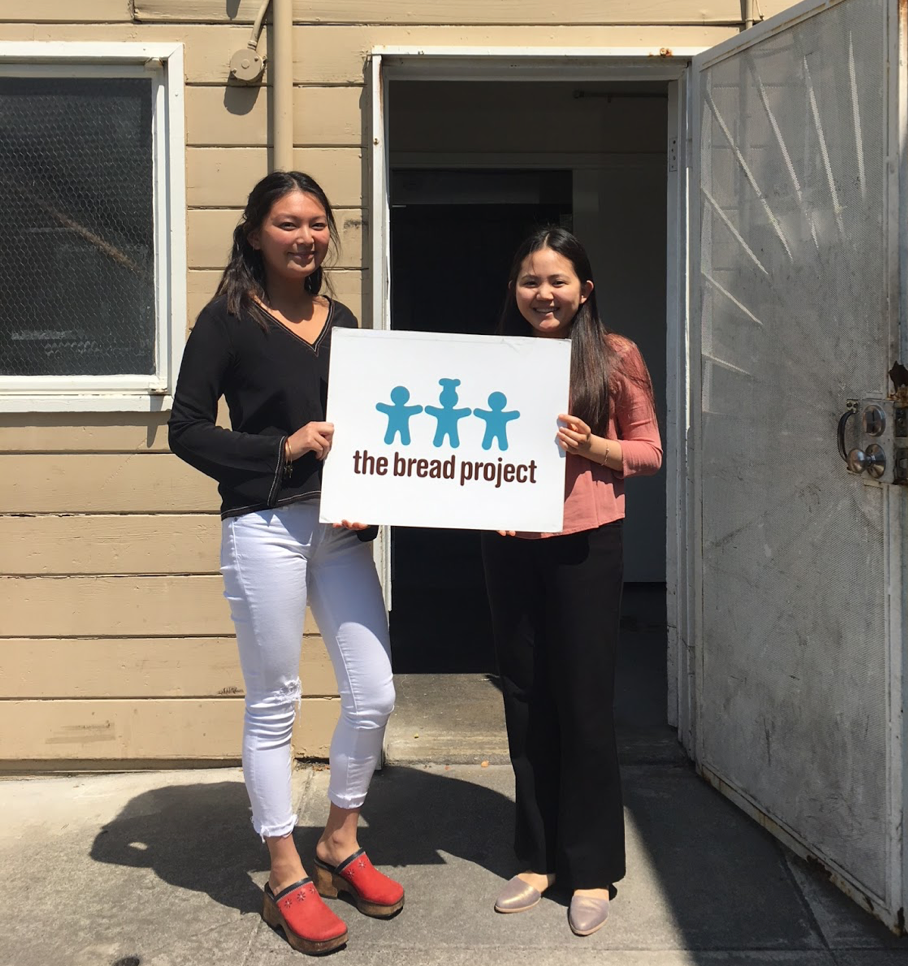

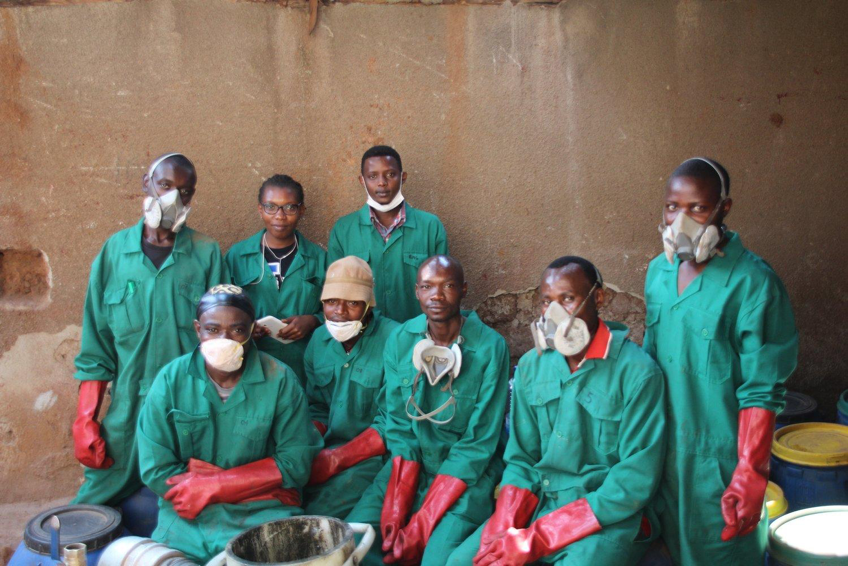

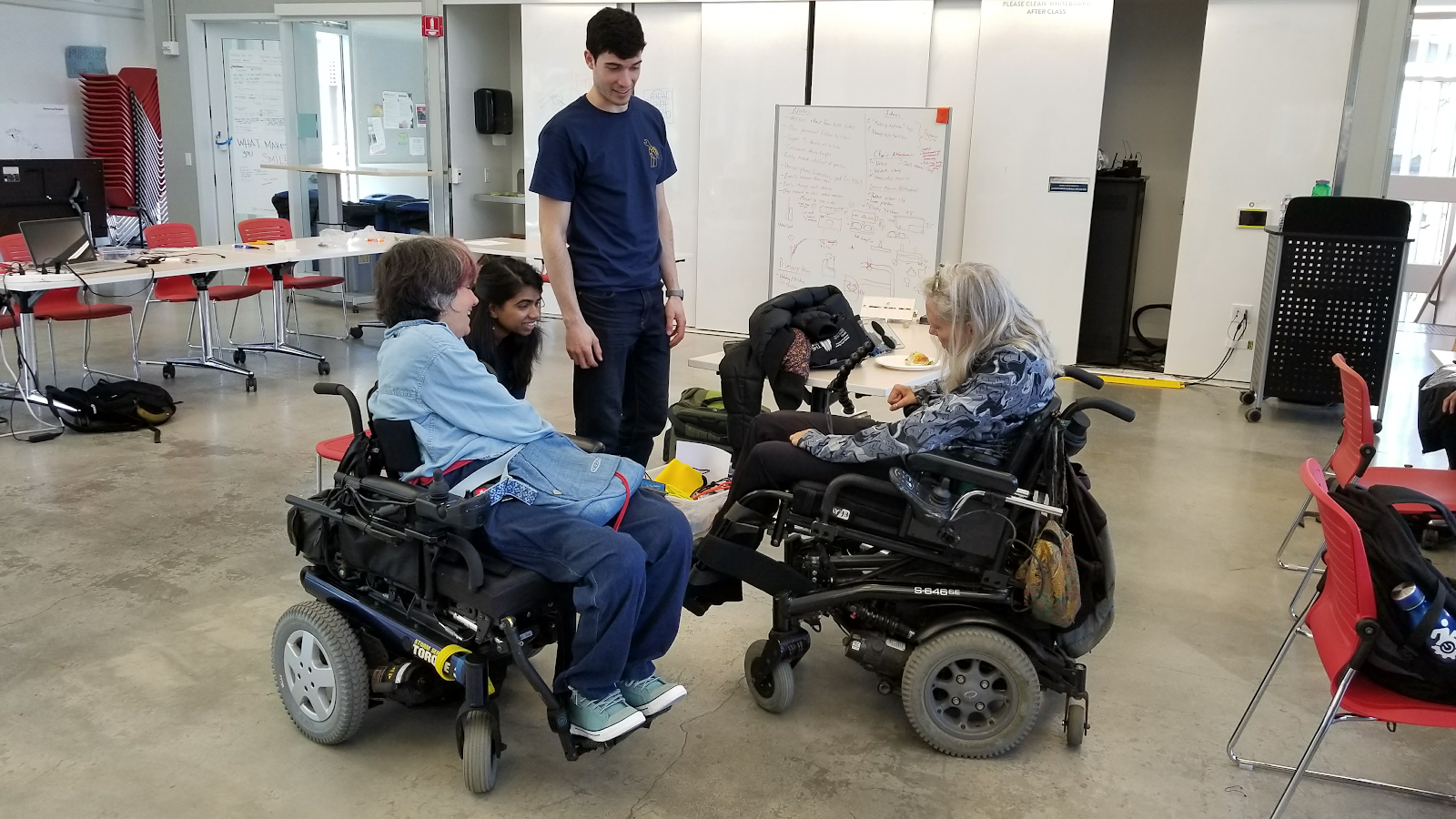


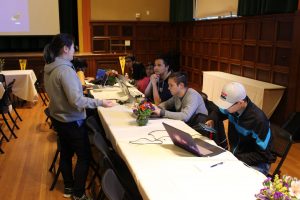
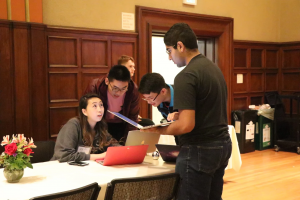

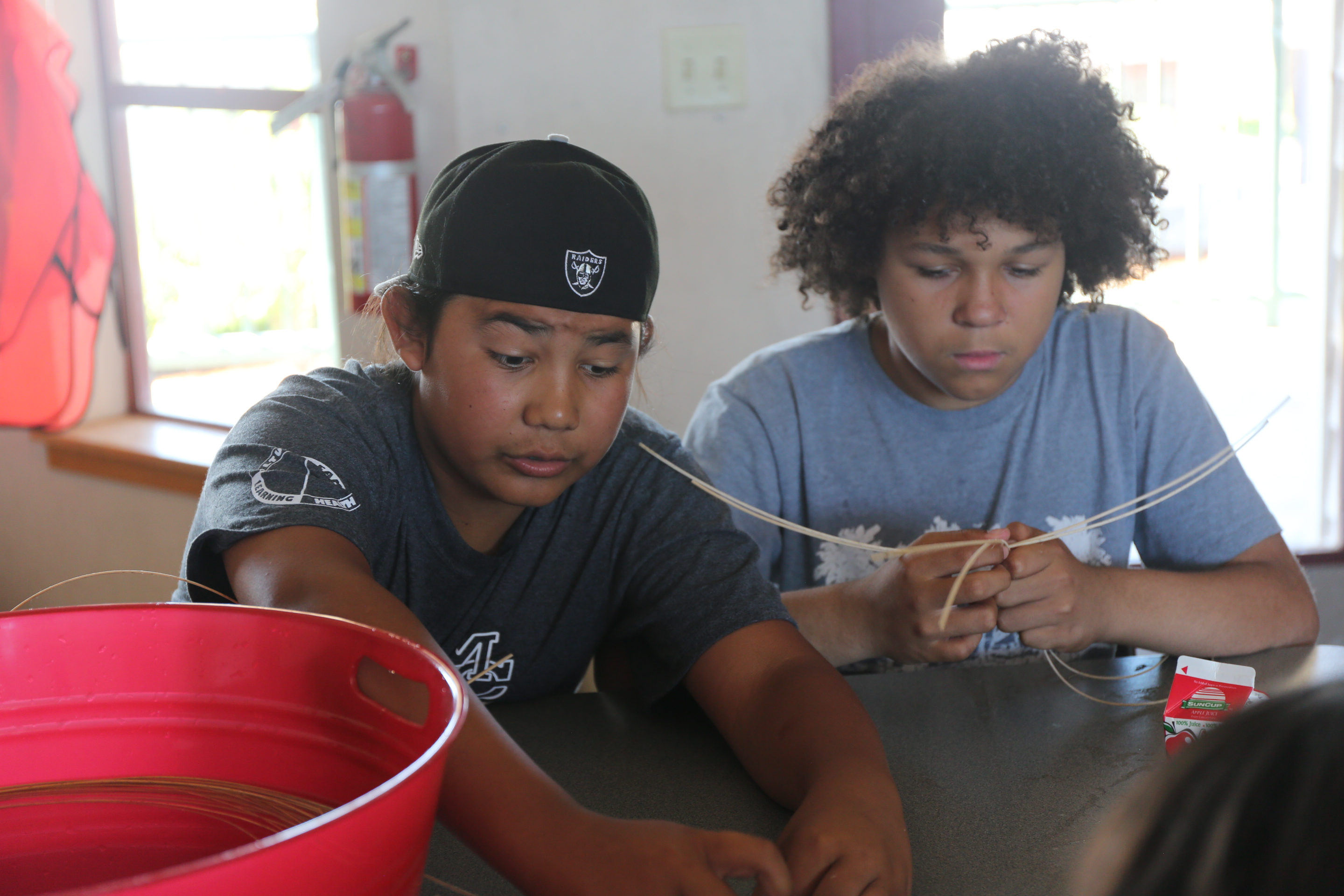 On the one hand, James, a mother of four, was eager to advance the education of young tribe members and teach them to live in two cultures. Yet her mind jangled with stories from her grandfather Smith Williams. He had told her about Ba-lay Ba-lin—the Bloody Run—an 1871 atrocity in which white settlers violently forced Native Americans off their land, turning the Eel River red with their blood. In 2007, when James first stepped onto the UC Berkeley campus to talk with Mechanical Engineering Professor Alice Agogino, now education director of the
On the one hand, James, a mother of four, was eager to advance the education of young tribe members and teach them to live in two cultures. Yet her mind jangled with stories from her grandfather Smith Williams. He had told her about Ba-lay Ba-lin—the Bloody Run—an 1871 atrocity in which white settlers violently forced Native Americans off their land, turning the Eel River red with their blood. In 2007, when James first stepped onto the UC Berkeley campus to talk with Mechanical Engineering Professor Alice Agogino, now education director of the 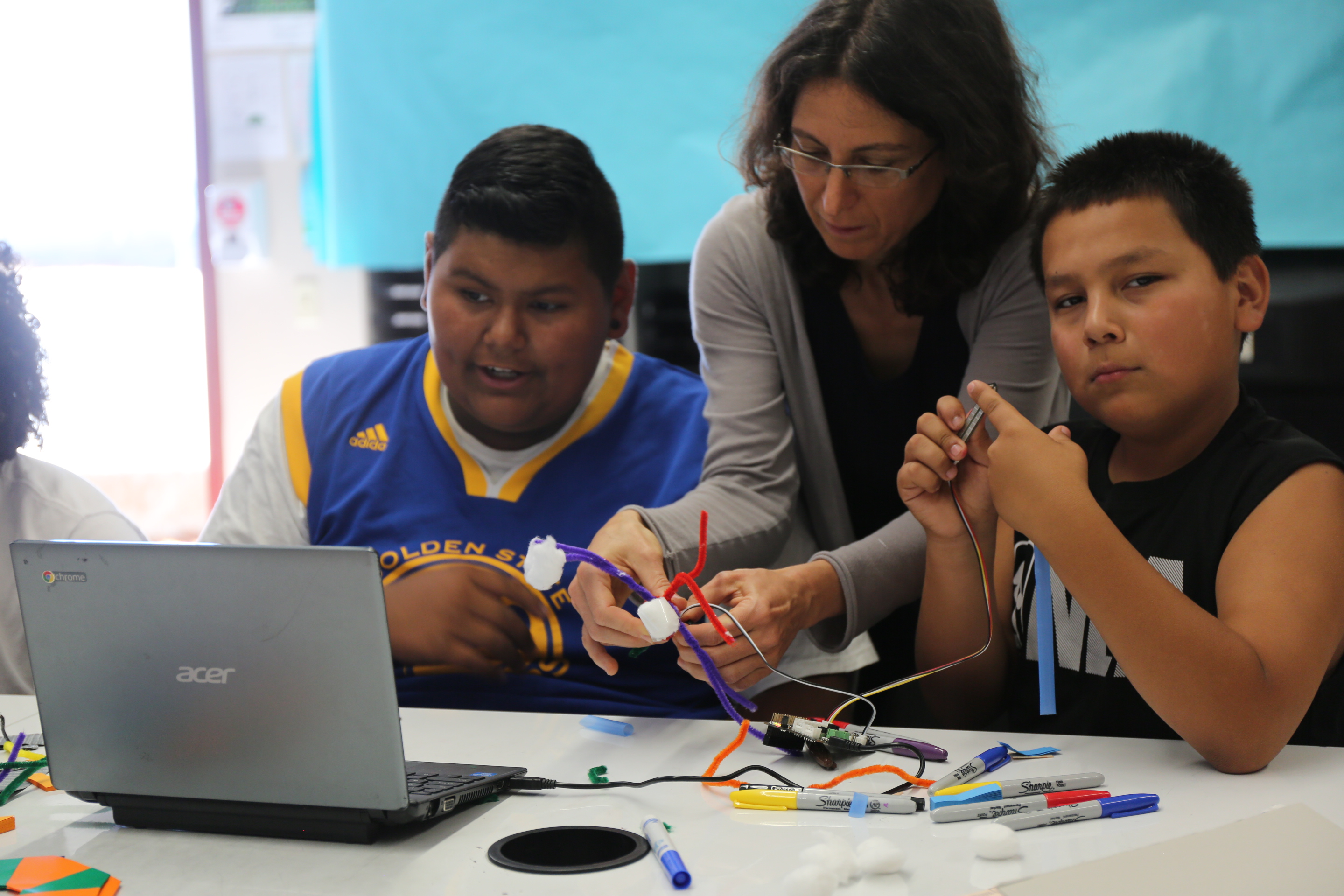 Like past collaborations, the recent educational one was the result of shared interests and available funding. Zhao Qui, project director of the Pomo Youth College and Career Success Project, explains that in October 2016 her organization received a Department of Education grant to fund new cultural and academic enrichment activities for native students; one area of concern was low access and achievement in math and science. At around the same time, the Blum Center received funding from the National Science Foundation to support development engineering students working on
Like past collaborations, the recent educational one was the result of shared interests and available funding. Zhao Qui, project director of the Pomo Youth College and Career Success Project, explains that in October 2016 her organization received a Department of Education grant to fund new cultural and academic enrichment activities for native students; one area of concern was low access and achievement in math and science. At around the same time, the Blum Center received funding from the National Science Foundation to support development engineering students working on 
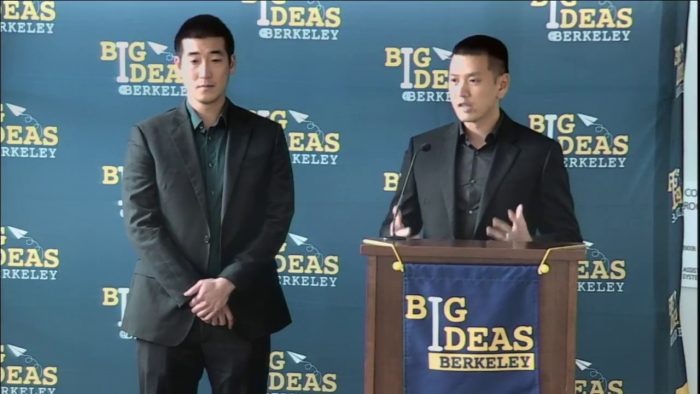 An injured soldier is rushed to a field hospital and is bleeding out. A surgeon needs to give the soldier meds to speed up her clotting. But too much or too little will kill her. The doctors rely on lab equipment to determine dosage; however, the large machine was never designed for field use. The surgeon is caught between an educated guess and blind dosing, putting the soldier’s life at risk.
An injured soldier is rushed to a field hospital and is bleeding out. A surgeon needs to give the soldier meds to speed up her clotting. But too much or too little will kill her. The doctors rely on lab equipment to determine dosage; however, the large machine was never designed for field use. The surgeon is caught between an educated guess and blind dosing, putting the soldier’s life at risk. 
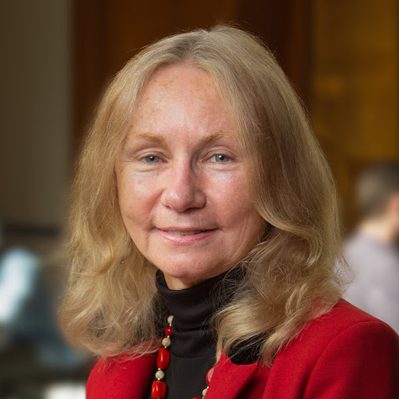 The award was
The award was 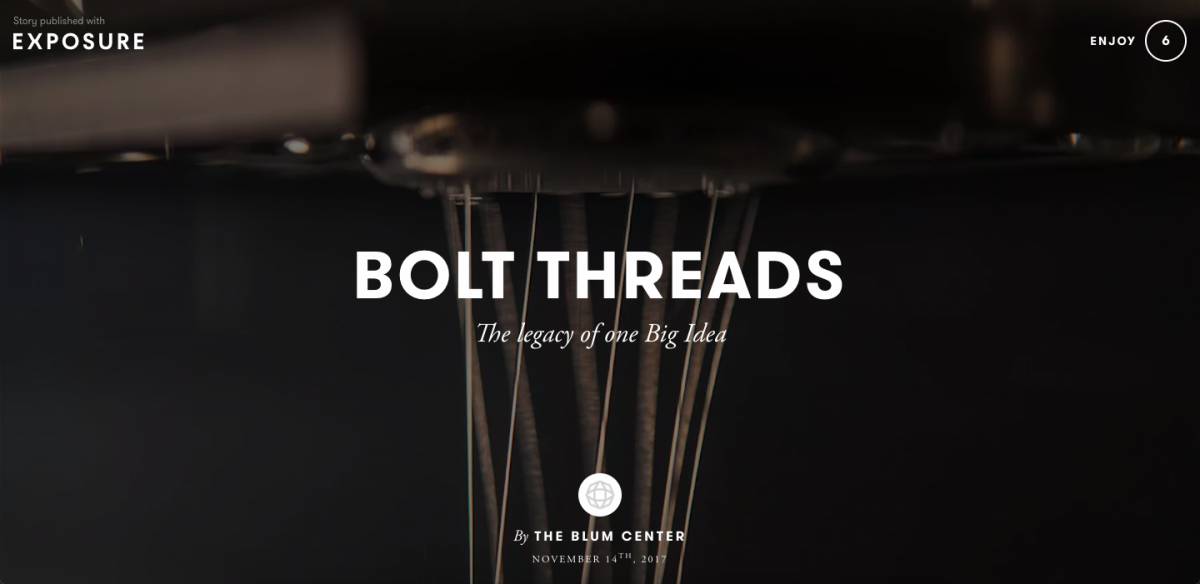






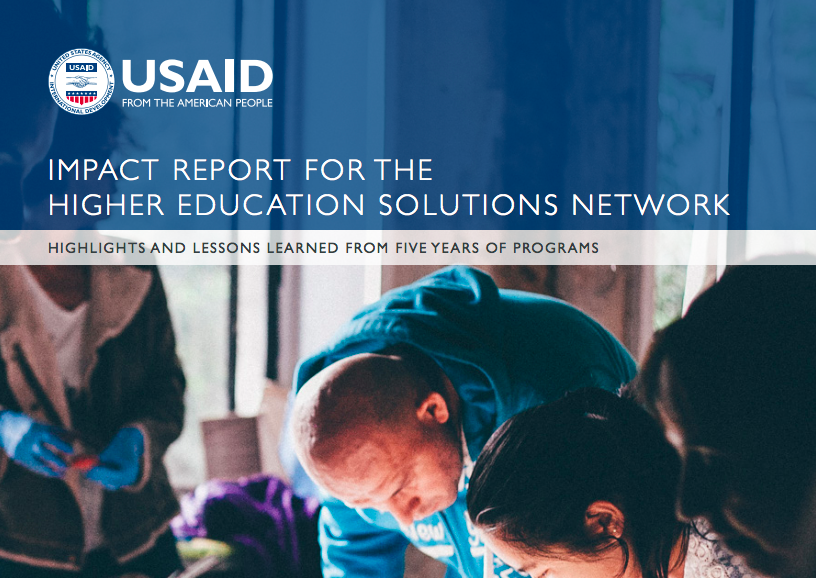

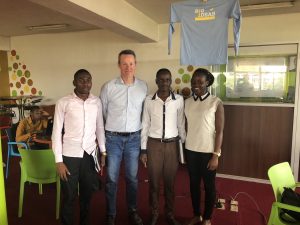
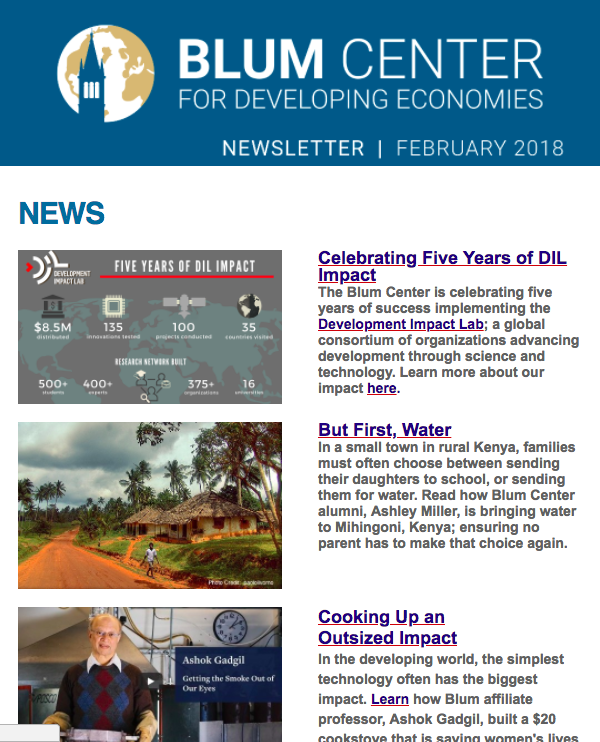


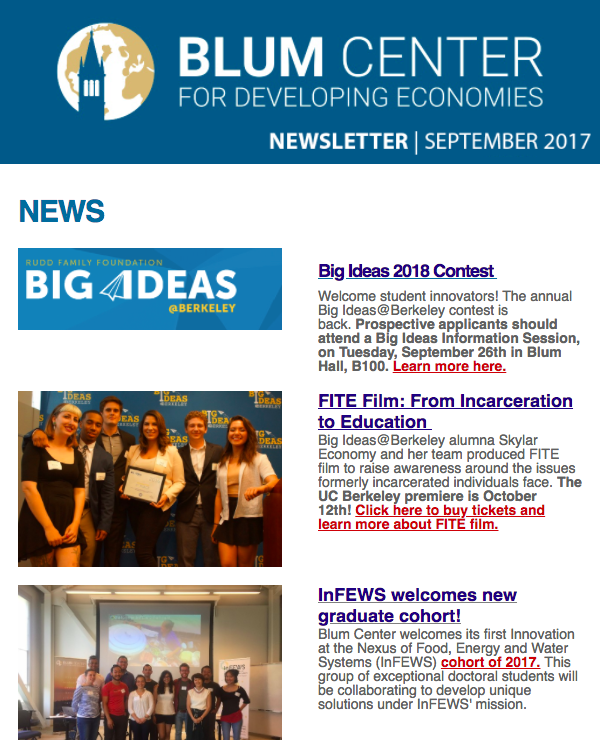
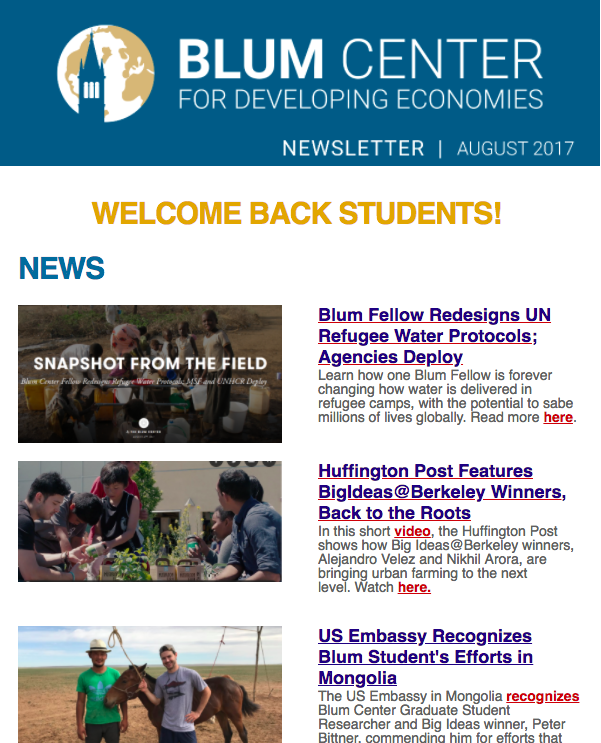
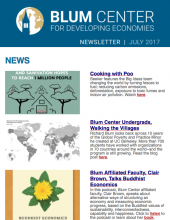

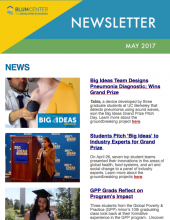
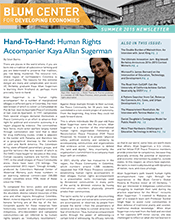
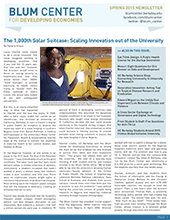
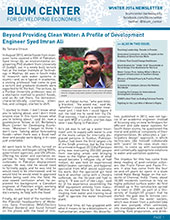


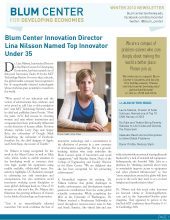
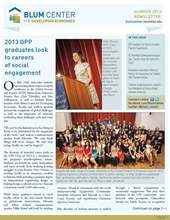

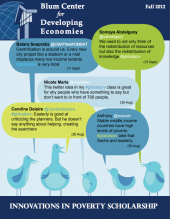
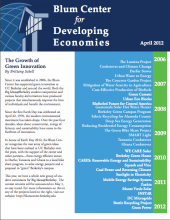

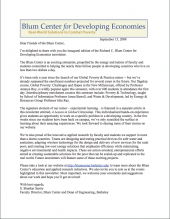
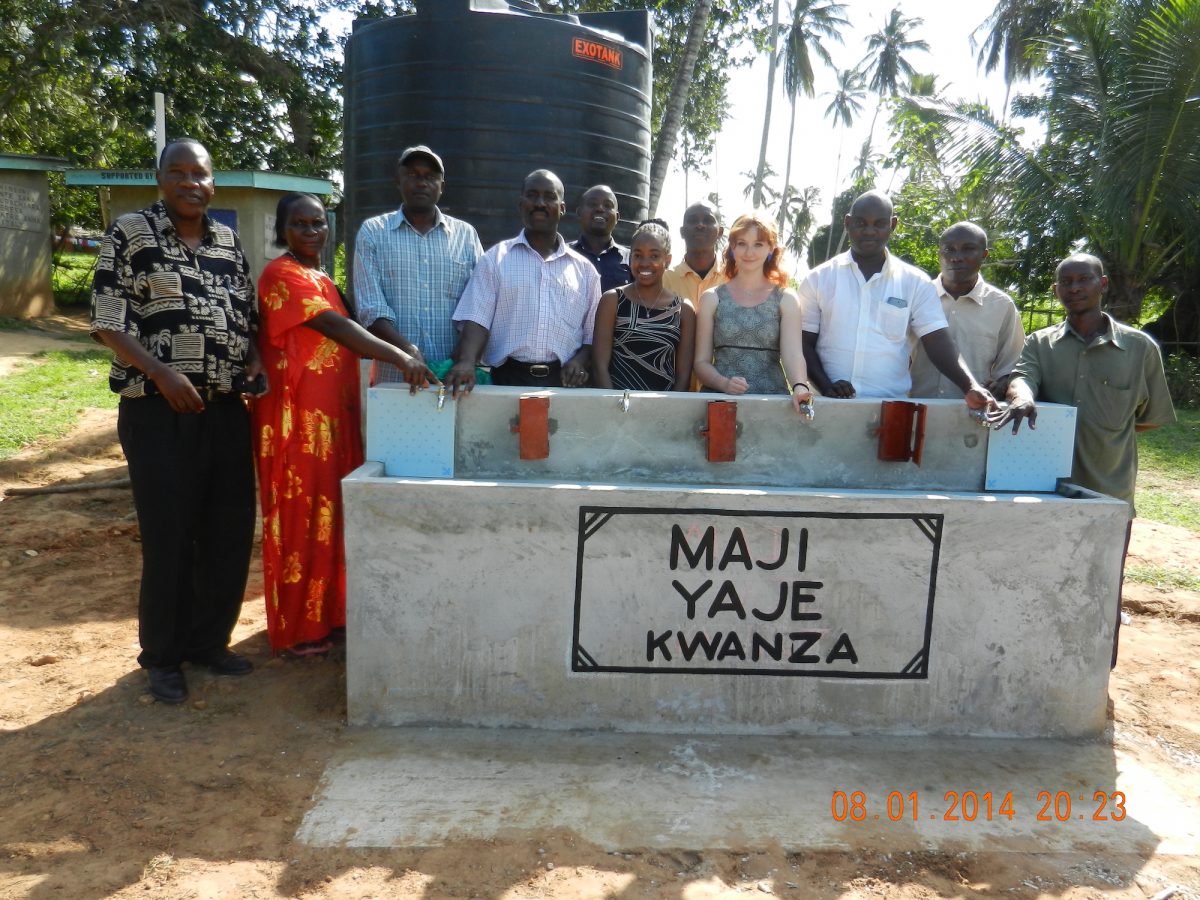
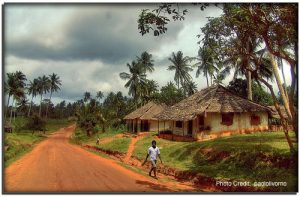 There is a saying in Swahili: “Maji Yaje Kwanza” which means “water is the first of many things”. The people of Mihingoni—most of whom are subsistence farmers—depend largely on rainwater for survival, but climate variability and long dry seasons continue to stunt crop yields. Low agricultural productivity decreases household income, and increases hunger. Lack of proper water, sanitation and hygiene leads to disease, and Kenya continues to have one of the worst under five mortality rates, globally. Families are forced to choose between sending their girls for water or sending them to school, and they choose water first. This limits the prospects for their future, and the cycle of poverty in Mihingoni continues. Until now.
There is a saying in Swahili: “Maji Yaje Kwanza” which means “water is the first of many things”. The people of Mihingoni—most of whom are subsistence farmers—depend largely on rainwater for survival, but climate variability and long dry seasons continue to stunt crop yields. Low agricultural productivity decreases household income, and increases hunger. Lack of proper water, sanitation and hygiene leads to disease, and Kenya continues to have one of the worst under five mortality rates, globally. Families are forced to choose between sending their girls for water or sending them to school, and they choose water first. This limits the prospects for their future, and the cycle of poverty in Mihingoni continues. Until now. “I didn’t want to make any assumptions about what the community needed, or what the solution should be,” Miller said. “The meeting was entirely spoken in KiGiriama, which allowed those most affected by the project to fully express themselves and their needs. We wanted to put the people’s needs at the center of all of our work.”
“I didn’t want to make any assumptions about what the community needed, or what the solution should be,” Miller said. “The meeting was entirely spoken in KiGiriama, which allowed those most affected by the project to fully express themselves and their needs. We wanted to put the people’s needs at the center of all of our work.”